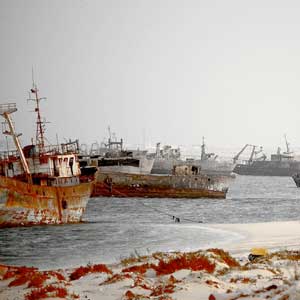The port of Nouadhibou, Mauritania
More than 300 ships are resting in the world’s largest ship graveyard. The practice of abandoning ships here started in the 1980s after the country’s fishing industry was nationalized.





(via Geolocation/crodenas, Filippo Minelli/Flickr, j-b.d/Flickr – 1, 2, Sebastián Losada/Flickr and Crazytopics)
Mo’ynoq (Muynak/Moynaq), Western Uzbekistan
The former sea port city has lots of rusting ships, abandoned since the 1980s due to the recession of the Aral Sea, which is now at least 95 miles (150 km) away from the former harbor.



(via United Nations Development Programme/Flickr and Martijn Munneke/Flickr)
Skeleton Coast, Namibia

The area was named after the whale and seal bones that littered the shore because of the whaling industry, but there are more than a thousand ships caught by rocks and fog.

(via Wikimedia Commons, by Anagoria, Patrick Giraud, Bel Adone and Joachim Huber/Flickr)
Staten Island Boat Graveyard or the Witte Marine Scrap Yard, NY

A dumping ground for disused and decommissioned ships in New York.


(via Bob Jagendorf/Flickr)
Military graveyard near Landévennec, France

The graveyard for (mainly naval) vessels is a bend on the Aulne River, used by the French Navy.

(via Vincent Maurin/Flickr – 1 – 2)
Grytviken, South Georgia, South Atlantic

The settlement was established in 1904 by a Norwegian sea captain as a whaling station for his fishing company. It was closed in December 1966, but the church is still used occasionally for marriages, and the whaling ships are still in the harbour.



(via Wikimedia Commons, by Liam Quinn, Serge Ouachée and Aah-Yeah/Flickr)
Gadani ship-breaking yard, Gadani, Pakistan

The world’s third largest ship breaking yard has a capacity of 125 ships of all sizes, including supertankers. In the 2009-2010 fiscal year, 107 ships were on the yard.

During the 1970s and 1980s, the ship breaking industry was on top, and Gadani was the largest breaking yard in the world.



(via Michael Foley/Flickr 1 – 2, Dawn and NGO Shipbreaking Platform/photos by Tomás Halda, 2010)
Bonus: Cemitério das Âncoras or The Anchor Graveyard, Tavira Island, Portugal

A portion of the beach is littered with hundreds of rusted anchors.

(via StartTheDay and Ricardo Santos)
Double bonus: Japanese Midget Submarines, 1945-1947

“At the end of World War II, Allied Occupation forces found hundreds of midget submarines built and building in Japan, including large numbers of the “Koryu” type. Many of these boats were in massed groups at shipyards and naval bases.”





 By
By 



